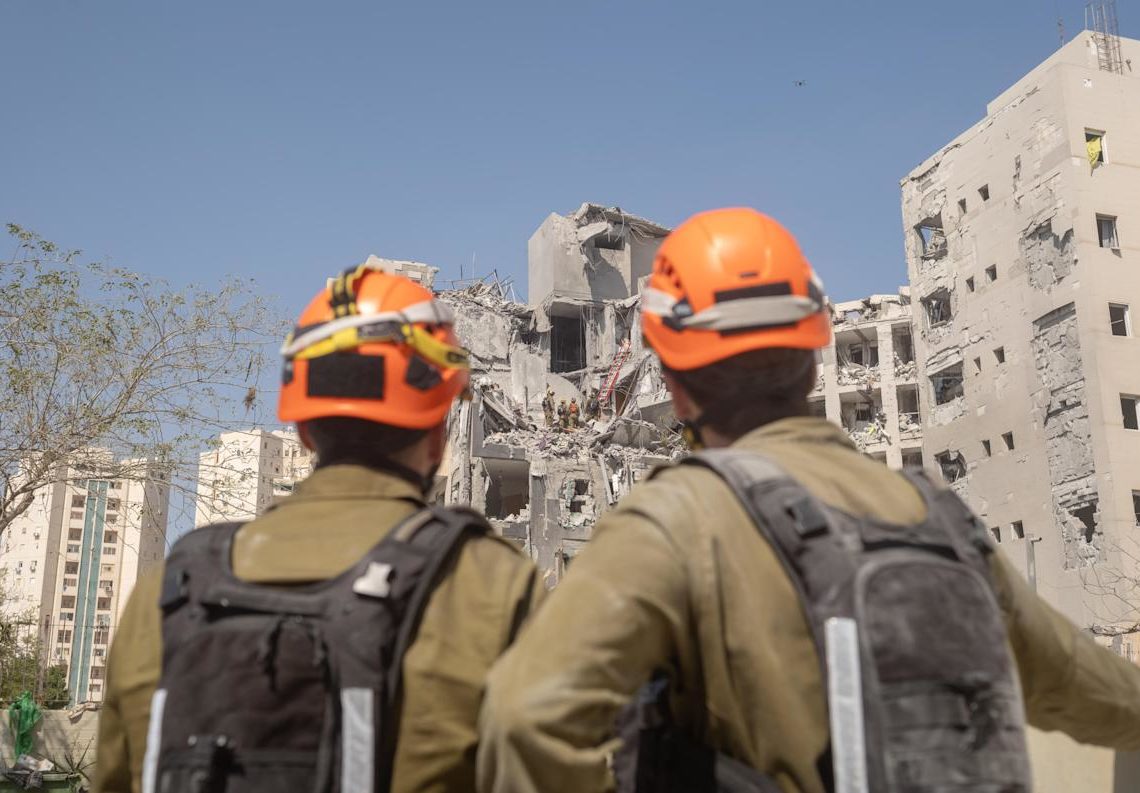President Trump voiced frustration with Israel and Iran on Tuesday morning after the Middle East’s arch rivals indicated they were complying with a ceasefire agreement he announced just hours earlier, but Israel then accused Iran of launching more missiles and vowed to retaliate. Mr. Trump said both countries had violated the ceasefire, and he demanded that Israel recall warplanes and not “drop those bombs.”
It was unclear whether Israel had already dispatched any jets to carry out new strikes on Iran, but Mr. Trump spoke after the Israeli defense chief said he had ordered further attacks on Tehran.
The U.S. president, after reportedly speaking directly with Israeli Prime Minister Benjamin Netanyahu on the phone, then posted a message on his social network declaring that Israel, “is not going to attack Iran. All planes will turn around and head home, while doing a friendly ‘Plane Wave’ to Iran. Nobody will be hurt, the Ceasefire is in effect! Thank you for your attention to this matter!”
The ceasefire agreement — which Iranian officials never formally confirmed they had begun honoring — appeared to falter within just a couple hours early Tuesday.
“In light of Iran’s complete violation of the ceasefire declared by the U.S. President and the launch of missiles towards Israel, and in accordance with the Israeli government’s policy as determined to respond forcefully to any violation — I have instructed the IDF, in coordination with the Prime Minister, to continue the intense activity of attacking Tehran to thwart regime targets and terrorist infrastructures,” Israeli Defense Minister Israel Katz said in a statement.
The Chief of the General Staff for Israel’s military, Lieutenant General Eyal Zamir, announced earlier that: “In light of the severe violation of the ceasefire carried out by the Iranian regime, we will respond with force.”
Reuters cited Iran’s semi-official ISNA student news agency as saying the Israeli claims of Iranian missile launches after the ceasefire began were false. The ISNA website was not immediately accessible, and there was no confirmation of that claim from Iranian officials publicly, but Iran’s state-run Press TV network also said the country “denies launching missiles after the ceasefire took effect.”
Asked as he prepared to depart for a NATO summit in the Netherlands on Tuesday — and before he said Israel would not bomb Iran — if he believed Iran or Israel had violated the ceasefire, Mr. Trump told reporters that both had, though he said “not intentionally,” and he was “not happy” with either nation.
“Iran did. Israel did, too. I’m not happy with Israel. Don’t go out first hour. Not happy with Iran, either,” the president told reporters, adding that the two countries “have been fighting for so long, that they don’t know what the f*** they’re doing. You understand that?”
In a separate message posted on his Truth Social network, Mr. Trump said: “ISRAEL. DO NOT DROP THOSE BOMBS. IF YOU DO IT IS A MAJOR VIOLATION. BRING YOUR PILOTS HOME, NOW!”
Israel claims Iranian attacks after ceasefire, Iran denies it
Israeli first responders said one Iranian missile hit the southern city of Beersheba on Tuesday morning, killing four people and wounding about 20 others.
Later, at about 3:30 a.m. Eastern Time, sirens blared in northern Israel and the Israeli military said it had “identified missiles launched from Iran.”
“Defensive systems are operating to intercept the threat,” the IDF said.
Mr. Trump had said on Truth Social, just after 1 a.m. ET Tuesday, that a ceasefire he announced earlier between the arch rivals, “IS NOW IN EFFECT. PLEASE DO NOT VIOLATE IT!”
In a statement, the Israeli government said that, “in light of achieving the objectives of the operation, and in full coordination with President Trump, Israel has agreed to the president’s proposal for a bilateral ceasefire,” adding a warning that Israel would “respond forcefully to any violation of the ceasefire.”
At about the same time, Iran’s state-run media said the country had also started to abide by the ceasefire, following a “parting shot with multiple rounds of strikes” on Israel.
But there was never any formal confirmation by Iranian officials, and Israel’s military reported Iranian missile launches within a couple hours of the time the deal should have taken effect.
Iranian Foreign Minister Abbas Araghchi indicated earlier that Iran would respect the ceasefire, but only if Israel did the same.
“There is NO ‘agreement’ on any ceasefire or cessation of military operations,” Araghchi wrote in a post on X. “However, provided that the Israeli regime stops its illegal aggression against the Iranian people no later than 4 a.m. Tehran time [8:30 p.m. Eastern], we have no intention to continue our response afterwards.”
He said a “final decision on the cessation of our military operations will be made later.”
Before Israeli alarms were heard in the north of the country, an IDF spokesperson said the ceasefire had gone into effect, but prior to that, Israel had attacked dozens of Iranian military targets throughout the night. The spokesperson said that before the ceasefire came into effect, about 20 missiles were fired from Iran towards Israel.
How the ceasefire deal announced by Trump took shape
Mr. Trump said Monday night that Israel and Iran had agreed to a “Complete and Total CEASEFIRE,” a move he said would end the 12-day conflict between the two countries.
The ceasefire would take hold in stages, the president said. A White House official told CBS News that Iran would halt strikes against Israel from midnight Eastern Time, and Israel was to stop striking Iran 12 hours after that, from noon ET on Tuesday. Another 12 hours after that, or at midnight ET on Wednesday morning, the war would be considered over.
In another Truth Social post later Monday night, following the Iranian foreign minister’s comments, Mr. Trump wrote, in part, that Israel and Iran “came to me, almost simultaneously, and said, ‘PEACE!’ I knew the time was NOW.”
Mr. Trump communicated directly with Netanyahu, while several other administration officials — Vice President JD Vance, Secretary of State Marco Rubio and Middle East envoy Steve Witkoff — communicated with Iran through direct and indirect channels, the White House official said.
Qatar helped broker the deal, another White House official said. Mr. Trump had asked the Qatari Emir to get Iran to agree to a ceasefire. Vance coordinated with the Qatari prime minister on details, and Iran agreed to the ceasefire after speaking to the prime minister. The official said the direct talks with Iran occurred after Iran’s strike on Al Udeid Air Base.
At least 1,000 people killed in 12 days of Israel-Iran strikes
The conflict between Israel and Iran began June 13, when Israel launched its first strikes against Iranian nuclear and military targets. The strikes — which killed several top Iranian military officials — prompted Iranian counterattacks on Israel.
As of Tuesday, at least 974 people have been killed, including at least 387 civilians and 268 Iranian military personnel, in Israel’s strikes on Iran, the Washington-based group Human Rights Activists in Iran said in a statement. The group relies on a network of contacts inside Iran for its information.
Iranian authorities have not provided casualty figures since not long after the Israeli strikes began.
Iran’s missile attacks have killed at least 28 people in Israel since June 13, according to Israeli officials.
The U.S. took military action against Iran over the weekend, striking three sites that are believed to be key to Iran’s nuclear program. The move sparked fears of a wider war, but Iran’s response on Monday was fairly limited. Iran fired more than a dozen missiles at a U.S. base in Qatar, most of which were intercepted, and no injuries were reported, U.S. and Qatari officials said.
Iran called its response “devastating and powerful,” but Mr. Trump called it “very weak.” The president said in another social media post that he wanted “to thank Iran for giving us early notice, which made it possible for no lives to be lost.”
Drones hit bases in Iraq housing U.S. troops
Iraqi army spokesperson Sabah Al-Naaman, in a statement quoted by the AP, said Tuesday that drones had hit military bases in the country, including some where American forces are stationed.
Al-Naaman said a “treacherous and cowardly act of aggression” had damaged radar installations at Camp Taji, north of Baghdad, and at the Imam Ali Base in Dhi Qar province in southern Iraq, not far from the Iranian border.
The AP cited Al-Naaman as saying Iraqi forces intercepted drones fired at other locations.
The AP cited a senior U.S. military official, whom it said was not authorized to comment publicly, as saying American forces had intercepted drones targeting the Ain al-Assad base in the western Iraq desert, and a base near Baghdad airport.
There were no reports of casualties, and no group immediately claimed responsibility for the attacks.
Iran-backed militias, often referred to as proxy groups, in Iraq had previously threatened to target U.S. bases in the region if the U.S. attacked Iran.
In response to news of a ceasefire, IAEA director Rafael Mariano Grossi said on social media that he “welcome(d) the announcements on Iran situation. Resuming cooperation with (the IAEA) is key to a successful agreement. I’ve written to (Iran’s foreign minister) stressing this step can lead to a diplomatic solution to the long-standing controversy over (Iran’s) nuclear program and proposed to meet soon.”
Kidney dialysis industry accused of maximizing profits over patients
Pentagon officials reveal new details about U.S. strikes on Iran’s nuclear sites
Extended interview: LQ Goldring on her quest for a kidney donor
The post Trump says Israel and Iran violating ceasefire, and he’s “not happy” appeared first on CBS News.



